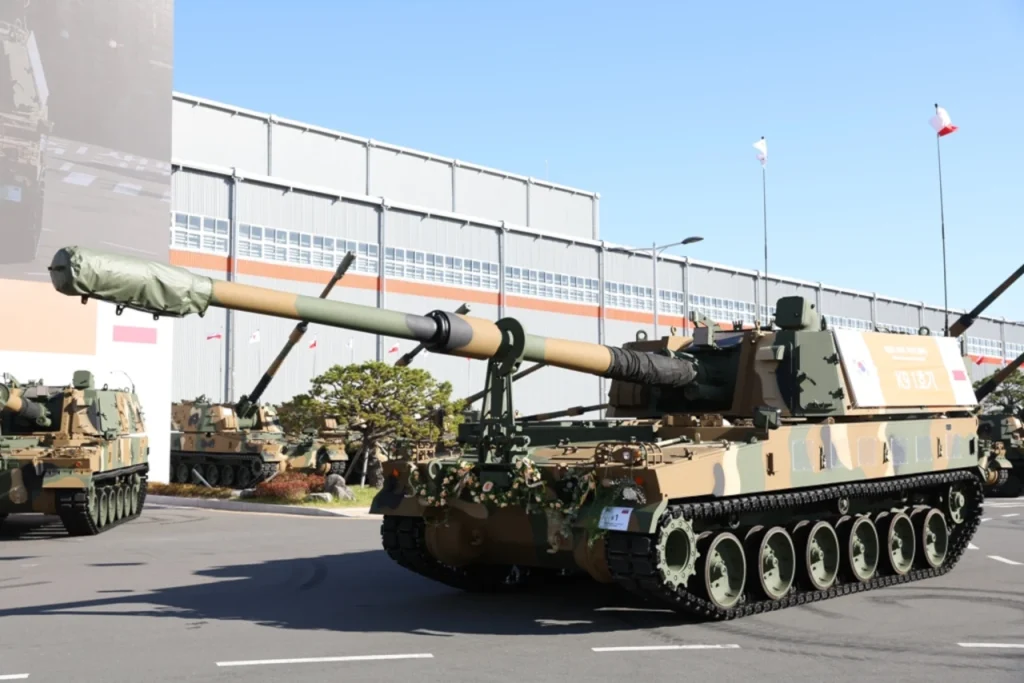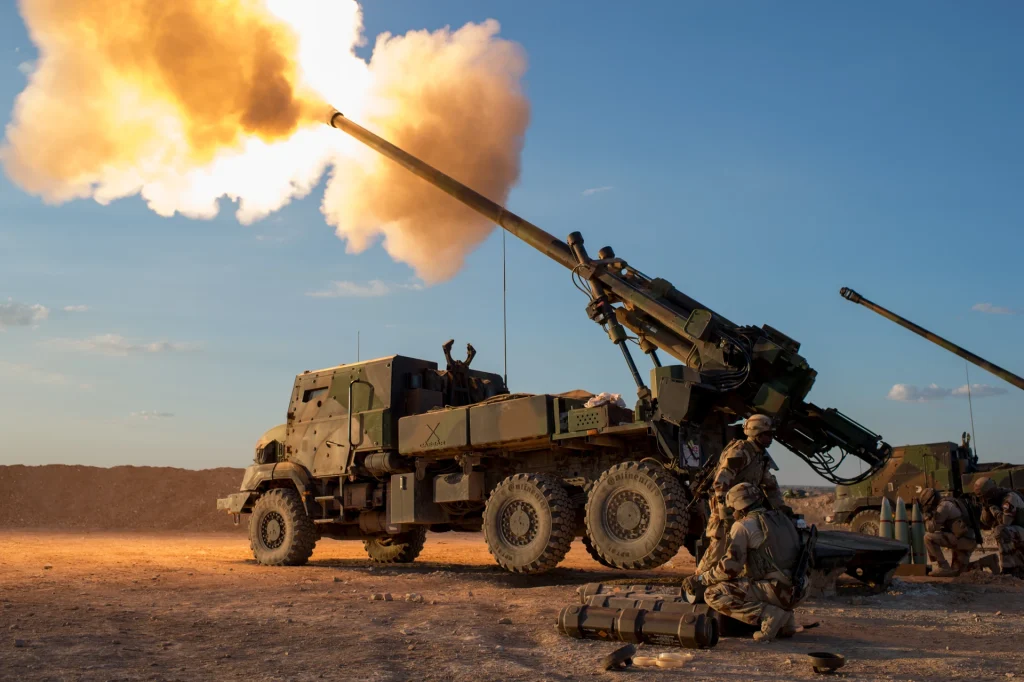Several European nations soon purchased K9 self-propelled howitzers and K10 advanced ammunition carriers from South Korea. It appears paradoxical that Germany produces the renowned PzH 2000 self-propelled howitzer, but it has only recently bagged an order from Hungary. At the same time, the Czech Republic has ordered just 52 CAESAR wheeled self-propelled howitzers from France.
The K10 armoured vehicle utilises the same chassis as the K9 and can carry up to 104 155 mm projectiles and a matching number of powder charges. Two K9 howitzers can be replenished with a single K10’s ammunition (2×48 pieces of ammunition). The ammunition is resupplied at a rate of up to twelve rounds per minute using a robotic arm feeder.
European orders for K9 Howitzers
Over the past few years, Poland, Norway, Finland, and Estonia have placed orders for K9 howitzers. In addition, Turkey produces South Korean K9 howitzers under the designation T-155 under licence. There are 1700 K9 howitzers in service, which accounts for sixty per cent of all self-propelled howitzers worldwide.
From 2017 to the present, the above named European nations, excluding Turkey, have placed firm orders for 380 K9 howitzers. Additional orders may come from the United Kingdom and Romania.
Poland
Poland has agreed to purchase 212 K9A1 howitzers for $2.4 billion and a substantial amount of ammunition. Hanwha Defense of South Korea showcased the first 24 Polish K9s at its Changwon factory on October 19, just two months after the Polish-Korean contract was signed. The first 24 K9s will be distributed to the 16th Division’s 1st Artillery Regiment. However, Poland did not purchase any K10 ammunition transports. The explanation appears straightforward: the K10 is priced similarly to the K9.
By the end of 2026, all 212 howitzers and the logistics package and training will be handed to the Polish armed forces. Poland plans to acquire a total of 672 K9A1/K9PL howitzers. All other Polish K9 howitzers (or K9PL variants) will be manufactured in Poland.
The Polish-Korean deal thus provides for the transfer of know-how and the building an artillery industrial base in Poland.
The K9PL will reportedly combine the developing K9A2 howitzer with a fully automated loading mechanism and Polish command and communication capabilities. In addition, based on the deployment of Polish Krab howitzers in Ukraine, various modifications to the ergonomics, functionality, and fire control system can be anticipated. The British Army is also issued a variant of the K9A2 through the Mobile Fires Platform programme.
Norway
Two weeks ago, Norway additionally ordered four K9 howitzers (in Norway, the howitzer is called K9 Vidar) and eight K10 ammunition vehicles as part of the option. The vehicles will arrive in Norway within two years. The new order expands the contract from 2017 – when Oslo confirmed the purchase of 24 K9 howitzers and six K10 ammunition vehicles. All vehicles of the first order are already in Norway. The option provides for purchasing up to 24 additional K9 howitzers. So Norway can expect to get 48 K9 howitzers.
Finland
Finnish Defense Minister Antti Kaikkonen approved the purchase of 38 extra 155mm/52 K9 Thunder self-propelled howitzers from South Korea, the Finnish Ministry of Defense stated on November 18, 2022. The Financing Committee of the Finnish Government authorised the transaction during its November 17 meeting. The overall price will be approximately 134.4 million euros. The second supplemental appropriation will fund them for the Finnish Ministry of Defense, designated for the rapid acquisition of military equipment for the Finnish armed forces in response to the situation in Ukraine. The 155 mm / 52 self-propelled howitzer K9 Thunder of South Korea is part of the Finnish army’s armoured brigade.

These 38 K9 self-propelled howitzers are part of the complete implementation of the option to the contract signed in February 2017 for purchasing 48 K9 self-propelled howitzers from the South Korean army by Finland. The contract included an option to purchase a further 48 K9 systems from the same source. In October 2021, the Finnish Minister of Defense approved the procurement of the first ten additional K9s for 30 million euros for 2021-2022. Now that the decision has been made to implement the option fully, the Finnish army will get 96 K9 self-propelled howitzers by the end of 2027.
Finland signed a 146-million-euro contract with the South Korean state foreign trade organisation KOTRA in 2017 to acquire 48 K9 self-propelled howitzers from the South Korean army, including the cost of training, spare parts, and service support. From 2017 through 2024, deliveries should be made to the Finnish Ministry of Defense. The option to acquire an extra 48 K9 howitzers has now been exercised.
K9 howitzers (received the Finnish designation 155 PSH K9 FIN and the name Moukari – throwing hammer) replace the obsolete Soviet 122-mm self-propelled howitzers 2C1 “Gvozdika” (Finnish designation 122 PSH 74) in the Finnish Defense Forces, of which 72 units were acquired in 1992 from the army of the former GDR.
The first shipment of four K9 self-propelled guns arrived in Finland in February 2018, and the first combat-ready battery of these systems will be created in Parola by the end of 2020. According to Finnish sources, the Finnish military has received at least 24 systems to date. Like their Norwegian counterparts, the Finnish howitzers are outfitted with Kongsberg’s unified digital combat control system and vehicle control ICS (Integrated Combat Solution).
Estonia
In 2018, Estonia purchased 12 outdated K9 howitzers for 46 million euros. All of these howitzers are already in Estonia. Before shipment, Hanwha Defense reconditioned the howitzers. In 2019 and 2020, Estonia purchased an additional twelve K9 howitzers. All 24 Estonian K9s will be upgraded to the K9 Kõu standard according to the 2021 contract. The howitzers will receive modern communications, a battle control system, a firefighting system, a new protective coating, and other electronics as part of the modernisation.
Lack of orders for European Howitzers
Germany produces a competitive howitzer, the PzH 2000, which makes the success of the South Korean K9 howitzer in Europe even more noteworthy. It has an outstanding “PR” and is the best in the world. The same can be said about French Caesars. So why are the Europeans ordering from South Korea given European solidarity?

There are numerous reasons, including political ones, but the most significant is the lack of PzH 2000 availability. German arms manufacturers need to produce howitzers quickly enough.
If we exclude the deliveries of used PzH 2000 howitzers to Croatia and Lithuania, Hungary placed its last order for 24 new PzH 2000 howitzers in December 2018. Before that, Qatar ordered 24 PzH 2000 howitzers in 2013. There are rumours of a planned sale of up to 100 PzH 2000 howitzers to Ukraine, although this transaction still needs to be finalised for apparent reasons.
Due to the numerous orders for South Korean K9 howitzers, the PzH 2000’s success in Europe over the past decade has been modest. South Korea not only produces a comparable product but also delivers K9 howitzers incomparably faster due to its significantly more robust arms sector. In addition to the K10 ammunition trucks
Hungary is expected to get all PzH 2000 howitzers by the end of 2023 after a 3.5-year delay. One can therefore estimate the German industry’s annual manufacturing capacity at 12 PzH 2000 howitzers. This production rate will meet the needs of Norway, Finland, Poland, and Estonia (Estonia purchases used K9s, although they were supplied swiftly).
Furthermore, it is impossible to boost howitzer’s output within a few years substantially. In addition to the production line’s output, the capabilities of the entire chain of hundreds of subcontractors are crucial. They must also provide spare parts and components for the construction of howitzers. Without them, the howitzers lose their combat effectiveness rapidly owing to heavy use in armed conflict, as shown in Ukraine.
